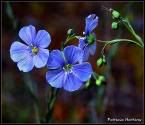

Scientific Name
Linum perenne
Uses of Blue Flax: Landscaping, Medicinal, Culinary, etc...
Grazing/rangeland: The cultivar 'Appar' is noted to have fair forage value for livestock and wildlife during spring and winter. It stays green throughout the growing season providing some forage value. Birds use the seed and capsules in fall and winter. All species of flax provide diversity to the seeded plant community.
Erosion control/reclamation: All species of flax are noted for their value in mixes for erosion control and beautification values.
Wildlife: The leaves and seed of flaxes are considered desirable forages for deer, antelope, and birds. Flax plants may also provide some cover for selected small bird species. They provide diversity to the plant community.
General Characteristics
Linum perenne is introduced from Eurasia. In general, flax is an annual or short-lived, semi-evergreen perennial forb, sometimes semi-woody at base with attractive flowers ranging from white to blue to yellow to red in color. Flax is common to the western United States.
Flax plants have many narrow, small, alternate (rarely opposite), simple and entire leaves that are sessile (lacking stalks) on the stems. The generally showy flowers are borne in clusters. The flower is five-parted, the fruit a capsule, and the seeds in most species are slimy when wet. Cultivated flax is grown both for fiber (flax) and for seed oil (linseed).
Required Growing Conditions
Flaxes do best on well drained soils. Most types do well on infertile, disturbed soils. They have excellent cold winter and drought tolerance. They will tolerate weakly saline to weakly acidic sites. They are usually found in open areas, but will tolerate semi-shaded conditions. They are fire resistant because the leaves and stems stay green with relatively high moisture content during the fire season.
Blue flax is distributed throughout the midwest to the northeastern portions of the United States.
Cultivation and Care
Flax should be seeded with a drill or broadcast at a depth of 1/4 inch or less into a firm seedbed. The ideal seeding depth is 1/8 inch. Flax is not recommended for single species seedings. The full seeding rate (not recommended) for this plant is 5 pounds Pure Live Seed (PLS) per acre or 30 PLS per square foot. When used as a component of a mix, adjust to percent of mix desired. For mined lands and other harsh critical areas, doubling the seeding rate of the flax component of a mix is not required. The best seeding results are obtained from seeding in late fall to very early spring (because many mixes contain cool season grasses) on heavy to medium textured soils and in late fall on medium to light textured soils. Late summer (August-mid September) seeding is not recommended. Dormant fall seedings (preferred seeding period for flax) will prechill seed and reduce seed dormancy which may be present. Mulching, irrigation, and weed control all benefit stand establishment. Seedling vigor is good, but not as good as most grasses. Germination normally occurs the first growing season, but may not occur until the second growing season. Full flowering should not be expected until at least the second growing season.Stands may require weed control measures during establishment. Because flaxes are broad-leaved, use of 2,4-D is not recommended. Mow weeds at or prior to their bloom stage. New stands may also be damaged by grasshoppers and other insects and pesticides may be needed.
General Upkeep and Control
Growth of flax begins in early spring and flowers appear in mid May through early July depending on species. Weed control and removal of very competitive species may improve flax establishment. Damage from wildlife and rodents may occur and these animals may need to be controlled.
Pests and Potential Problems Disease problems are minimal with flax.
Environmental Concerns Flax species establish and spread relatively quickly via seed distribution. They are not considered weedy or invasive species, but can spread into adjoining vegetative communities under ideal climatic and environmental conditions. They coexist with other species and add biodiversity to those plant communities.
Cultivars, Improved, and Selected Materials (and area of origin) 'Appar' blue flax (Linum perenne L.) is a selected release from seed originally collected in the Black Hills of South Dakota. 'Appar' was selected by the Aberdeen, ID Plant Materials Center for outstanding vigor, beauty, and competitiveness with grasses prevalent on sites where it was collected. It was released in 1980 by the Natural Resources Conservation Service, University of Idaho Agricultural Experiment Station, Utah Division of Wildlife Resources and the Forest Service Forest and Range Experiment Station. 'Appar' was released as a native flax (Linum lewisii), but was later determined to be a naturalized species from Europe. 'Appar' was named in honor of A. Perry
Plumber, Forest Service who collected the original material. 'Appar' is a hardy, relatively short-lived, introduced perennial forb, 12 to 36 inches tall with deep blue flowers that bloom profusely for about six weeks beginning in mid May. It is well adapted to sunny open slopes, well drained soils from moderately basic to weakly acidic, 10 to 18 inch rainfall areas, at 1,000 to 6,000 feet elevation. It has some shade tolerance, but is not tolerant of poor drainage, flooding, or high water tables. It does well seeded in mixtures with other species. Its intended uses are erosion control, reclamation, highway right-of-ways, homes, gardens, parks, diversity and beautification. Certified seed is readily available through commercial sources and breeder seed is maintained by the Aberdeen Plant Materials Center. Foundation and registered seed are available for each variety through the appropriate state Crop Improvement Association or commercial sources to grow certified seed.





0 comments: